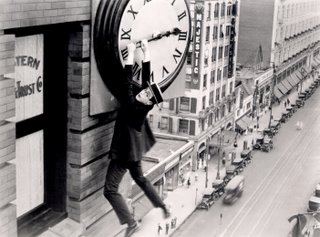Harold Lloyd - Silent Comedy's Adventure Capitalist

Harold Lloyd's silent comedies -- once among the most popular of the era -- were rarely seen for a number of years due to squabbles over ownership, but one image of Lloyd has remained indelible in pop consciousness: the picture of a man in a dark business suit and round horn-rimmed glasses, hanging for dear life from the hour-hand of a clock high atop a tall building in some downtown American metropolis.
Thrilling and funny within its context (the 1923 feature Safety Last), it is also portentous, and a little bit haunting -- and not just incidentally. More than any other major comedian of the era, Lloyd sought identification as a budding American capitalist, usually a smart, hard-working yet kind-hearted junior clerk who has his sights set on the top of the corporate ladder. For the capitalist, the image is a chilling metaphor: money is time, time is money, timing is everything, and even those who have climbed to the top (in this case, literally) are only holding on for dear life by the most slender of handles. The identification behind Lloyd's on-screen character (so close in so many ways to his own personality), for all its jaunty optimism as well as for its underlying recognition of how fragile the world of the capitalist can be, was perhaps the secret of Lloyd's popularity.
Young Harold, who was born on this day in 1893 in Burchard, Nebraska, grew up as a resourceful lad in a habitually relocating Midwestern family -- delivering telegraph messages or newspapers, soda-jerking, selling popcorn, anything to supplement the meager family income. In 1907, the family settled in San Diego, just as the film industry was beginning to move into California. Lloyd caught the show business bug working as an usher in theaters and in small parts in the local rep companies before landing his first screen bit, as a Yaqui Indian in an Edison film in 1912.
In Los Angeles, he eventually caught on as a regular extra at Universal, where he met another young extra named Hal Roach. In 1914, Roach inherited some money and decided to start his own film studio, inviting Lloyd along to play a comic character in a handful of short films which were ultimately never released. One of Roach's shorts did manage to catch the attention of Pathe for distribution, and after a brief falling out between Roach and Lloyd over wages, Lloyd signed on to create a Chaplin knock-off character, "Lonesome Luke," a tramp in tight clothes as opposed to Chaplin's baggy ones. While neither Roach nor Lloyd really cared much for the character, it was very popular, and together with Bebe Daniels and Snub Pollard, Lloyd made over 100 "Lonesome Luke" shorts during 1916-7.
Half-way through "Luke's" run, however, Lloyd and Roach convinced Pathe to accept a new character Lloyd was working on, an average-looking all-American young man in regular clothes and horn-rimmed glasses; and by 1918, Lloyd's "glasses" character became one of Hollywood's most popular comic characters. Not only was he a bright, diligent gent, but he would often find himself in some spectacularly precarious physical predicaments -- tottering around the high girders of a skyscraper under construction, edging along lofty ledges or hanging from the connection rod of an out-of-control streetcar -- earning him the nickname "king of daredevil comedy." He performed these stunts despite the loss of his right thumb and forefinger when a prop bomb went off in his hand during the filming of Haunted Spooks (1920); if you look closely, he always wore thick gloves in his movies which concealed prosthetics, and his right hand was almost always in his pocket for posed photographs.
During the 1920s, Lloyd jumped from shorts to feature films, including: Dr. Jack (1922) and Safety Last (both of which featured his soon-to-be-wife, Mildred Davis); Why Worry? (1923, in which our Harold becomes involved in a revolution in a small Latin American country, yet another mythically pregnant setting for Lloyd as adventure capitalist); Girl Shy (1924); Hot Water (1924); The Kid Brother (1927); and Speedy (1928).
Having left Roach in 1923, he produced his own films, and charted his own destiny into a few sound comedies, but age was catching up with his young-man-in-a-hurry image and his voice did not seem to match well, either. Lloyd shrewdly took his profits and closed the doors on his storefront after only a few talkies, retiring to his 44-room Italian Renaissance-style villa in Beverly Hills.
Preston Sturges coaxed him out of retirement in 1947 for a Howard Hughes production, Mad Wednesday, which begins with a cynical joke on Harold's old image: we see the young capitalist busy at his desk, followed by a calendar montage which brings Harold from 1925 to 1945, still sitting at the same desk, without discernible change in station. The film was a flop -- perhaps because audiences would rather have imagined young Harold the capitalist as the eventual retiree in a 44-room villa than as a drudge at a desk -- and Lloyd went back into retirement, emerging occasionally to revive his films, as he did at Cannes in 1962 to a standing ovation. Lloyd passed away in Beverly Hills on March 8, 1971.
Labels: Silent Film





0 Comments:
Post a Comment
Subscribe to Post Comments [Atom]
<< Home